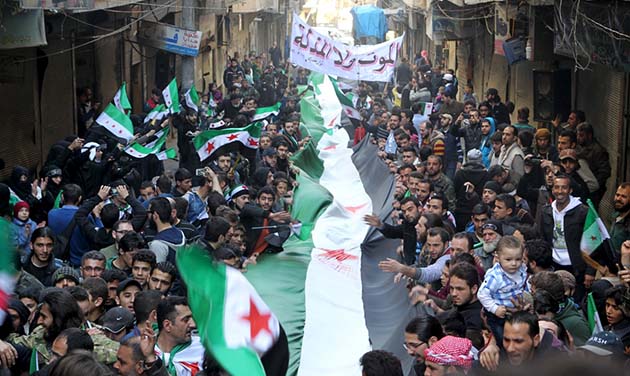Syrians in opposition-held territories marked the fifth anniversary of the revolution with protests in over 100 locations, declaring “the revolution continues.”
In 2011 Fridays always saw the biggest protests against dictator Bashar al-Assad. So on the first Friday following a truce brokered by the US and Russia crowds took to the streets in Aleppo, Homs, Daraa and the Damascus countryside, reviving the slogans of the 2011 uprising: “The Syrian people want freedom”, “the people want to overthrow the regime” and “death rather than humiliation.”
In Idlib and Maarat Al-Naaman protesters were attacked by soldiers from the jihadist group Jabhat al-Nusra.
The protests are a reminder of the continuing opposition amongst the Syrian people both to Assad and the jihadist groups. The uprising began when peaceful demonstrations, inspired by the Arab Spring, called for the end of the Assad dictatorship. But ruthless bombing and repression from the regime turned the revolt into a civil war, allowing jihadist groups to establish a foothold and opening the door to imperialist intervention.
The initial revolution and its aims of a free, democratic Syria without sectarian divisions has retreated in the face both of Assad’s bombs and reactionary Islamist groups like Islamic State and Jabhat al-Nusra.
Most recently, Syria’s largest city, Aleppo, which remains in opposition control, has been utterly decimated by regime and Russian bombs, displacing 200,000 people.
Aleppo is now effectively encircled by the combined forces of Russia, the Syrian regime and Shia sectarian militias of Iran, Iraq and Lebanon.
Russian intervention
Syria is now increasingly a plaything of foreign imperialist powers. The commencement of bombing by Russia last September shifted the balance in favour of the regime, and despite claiming to target Islamic State (IS), Russian airstrikes overwhelmingly hit other rebel groups.
The offensive has fragmented opposition territory. As Foreign Policy magazine described, “Russian airpower allowed Assad and his allied paramilitary forces to finally cut off the narrow, rebel-held ‘Azaz corridor’ that links the Turkish border to the city of Aleppo.”
Idlib, another rebel-held province is also cut off from vital supply lines. The regime is strangling the life out of these rebel holdouts, in a manner that has been on graphic display in Madaya, whose population is dying of starvation under siege.
This strategy allows the regime to wear down its opponents without exposing its own forces to significant risk.
Russia’s deployment also frustrated Western efforts to build up their own influence in Syria, by targeting rebel groups looking to them for support. This is designed to force a settlement with the West that leaves a Russian-backed Assad regime in power.
Russian support for Assad is designed to secure its influence in the Middle East—Russia’s only Mediterranean naval base is in the Syrian city of Tartus.
Russia also hopes to use Syria as a bargaining chip to pressure the US and EU to drop sanctions over Russia’s 2014 annexation of Crimea from Ukraine. Its intervention in Syria shows it can still throw its weight around on the world stage.
Truce
Fighting has temporarily halted under the ceasefire that came into effect on 27 February, despite a number of violations. This is the first nationwide truce in the conflict, although it does not include jihadist groups Jabhat al-Nusra or Islamic State.
UN-sponsored negotiations between the regime and opposition were resuming as Solidarity went to press but are deadlocked over the issue of political transition. Assad claims to be introducing reforms like setting a date for parliamentary elections and proposing a “national unity government” that would co-opt members of the opposition but leave the presidency untouched. The opposition won’t tolerate Assad remaining president.
At least a quarter of a million people have lost their lives in this war. But with so many global and regional powers invested in Syria, the conflict still threatens to escalate.
Turkey and Saudi Arabia are considering bombing campaigns, and even sending in ground troops.
Russian Prime Minister Dmitry Medvedev warned that the commitment of Saudi troops could result in a “new world war,” adding that “a ground operation draws everyone taking part in it into a war…The Americans and our Arab partners must consider whether or not they want a permanent war.”
Some are speculating that the only viable option may be partition. But top-down negotiations won’t end the bloodshed or remove the dictatorship.
Only a revival of the revolutionary movement in Syria and the wider Middle East can deliver the freedom and justice Syrians fought and died for five years ago.
By Lachlan Marshall





